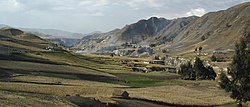Rift valley



A rift valley is a linear shaped lowland between several highlands or mountain ranges produced by the action of a geologic rift. Rifts are formed as a result of the pulling apart of the lithosphere due to extensional tectonics. The linear depression may subsequently be further deepened by the forces of erosion. More generally the valley is likely to be filled with sedimentary deposits derived from the rift flanks and the surrounding areas. In many cases rift lakes are formed. One of the best known examples of this process is the East African Rift.[1] On Earth, rifts can occur at all elevations, from the sea floor to plateaus and mountain ranges in continental crust or in oceanic crust. They are often associated with a number of adjoining subsidiary or co-extensive valleys, which are typically considered part of the principal rift valley geologically.
Earth's rift valleys
The most extensive rift valley is located along the crest of the
Many existing continental rift valleys are the result of a failed arm (
Other rift valleys are the result of bends or discontinuities in horizontally-moving (strike-slip) faults. When these bends or discontinuities are in the same direction as the relative motions along the fault, extension occurs. For example, for a right lateral-moving fault, a bend to the right will result in stretching and consequent subsidence in the area of the irregularity. In the view of many geologists today, the Dead Sea lies in a rift which results from a leftward discontinuity in the left lateral-moving Dead Sea Transform fault. Where a fault breaks into two strands, or two faults run close to each other, crustal extension may also occur between them, as a result of differences in their motions. Both types of fault-caused extension commonly occur on a small scale, producing such features as sag ponds or landslides.
Rift valley lakes
Many of the world's largest lakes are located in rift valleys.
Extraterrestrial rift valleys
Rift valleys are also known to occur on other terrestrial planets and natural satellites. The 4,000 km long
References
- ^ "The Ethiopian Rift Valley". Giacomo Corti-CNR.
- ^ "The World's Greatest Lakes". Archived from the original on 2020-06-19. Retrieved 2020-06-18.
- ^ "Lake Baikal – World Heritage Site". World Heritage. Retrieved 2007-01-13.
- ^ "The Oddities of Lake Baikal". Alaska Science Forum. Archived from the original on 2012-04-19. Retrieved 2007-01-07.
- S2CID 209833822.
The best explanation is that Lake Vostok may lie in a rift valley, as does Lake Tanganyika in East Africa and Lake Baikal in Russia. The geography of Lake Vostok is indeed consistent with this notion, in that the lake has a crescent shape, just like Tanganyika and Baikal, and the side walls of the lake are relatively steep, at least on one side.
- ISBN 0-7167-7696-0.
- ISSN 0148-0227.
- ISSN 0148-0227.
- .
- ISSN 0148-0227.
- S2CID 129537658.
- ^ Dunn, Marcia (16 July 2015). "'Blowing my mind': Peaks on Pluto, canyons on Charon". PhysOrg.
- S2CID 4452730.
- ^ Chaikin, Andrew (2001-10-16). "Birth of Uranus' provocative moon still puzzles scientists". space.com. Imaginova Corp. p. 1. Archived from the original on July 9, 2008. Retrieved 2007-07-23.
- ^
Smith, B. A.; Soderblom, L. A.; Beebe, A.; Bliss, D.; Boyce, J. M.; Brahic, A.; Briggs, G. A.; Brown, R. H.; Collins, S. A. (4 July 1986). "Voyager 2 in the Uranian System: Imaging Science Results". Science. 233 (4759): 43–64. S2CID 5895824.
Further reading
- Bonatti, E (1985). "Punctiform initiation of seafloor spreading in the Red Sea during transition from a continental to an oceanic rift". Nature. 316 (6023): 33–37. S2CID 4355790.
- Mart, Y.; Dauteuil, O. (2000). "Analogue experiments of propagation of oblique rifts". Tectonophysics. 316 (1–2): 121–132. .
